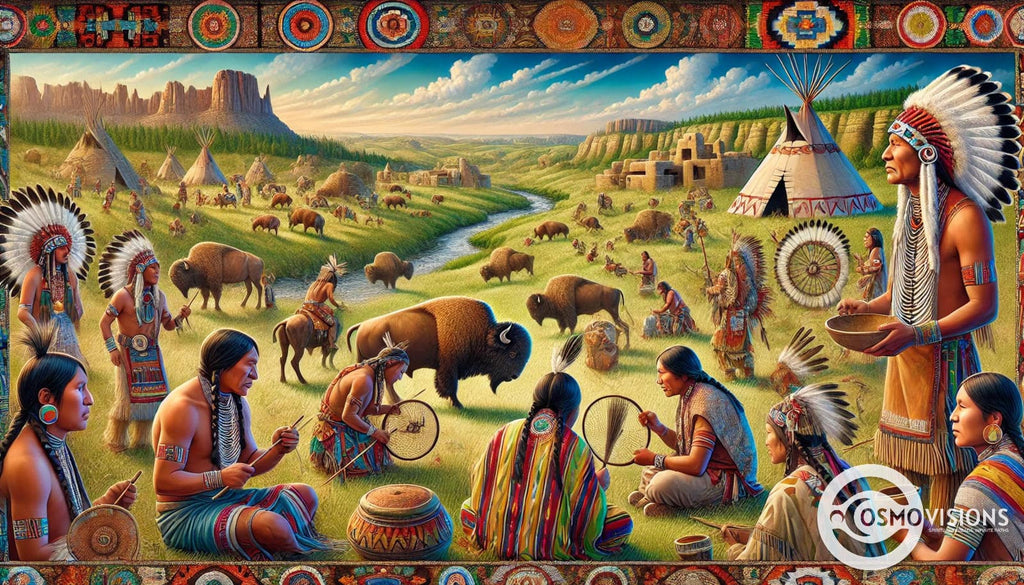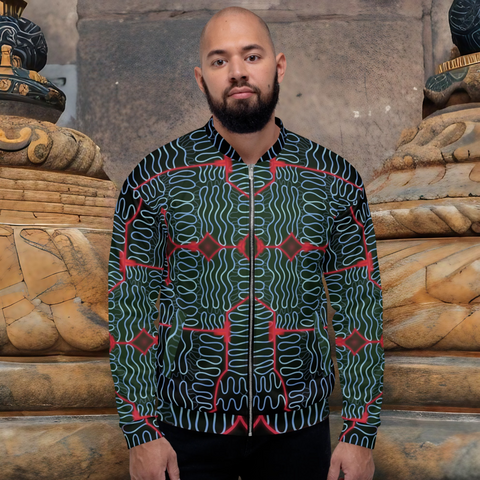Exploring Native American Tribes: History, Art, Culture, & Facts
Posted by Massimiliano Geraci

Understanding the rich tapestry of Native American tribe, their history, art, culture, and facts can often feel like an overwhelming journey. Many yearn to connect with or learn more about the profound depth and diversity that Native American heritage offers but find themselves lost amidst a sea of information.
The intricate social structures, governance, spiritual practices, and artistic expressions form a mosaic as varied as the landscapes they inhabit.
A fascinating starting point is that there are 574 federally recognized tribes in the United States today. This fact alone underscores the vastness and the vibrancy of Native American communities—each with its own unique traditions, languages, and histories.
Our article aims to bridge gaps in understanding by offering detailed explorations into how these tribes have lived and organized historically and how they continue to contribute significantly to society.
Our narrative will guide you through this rich heritage with clarity and insight.
Discover their stories with us.
Who Are the Native American Tribes?
Native American tribes comprise the indigenous peoples who inhabited North America long before Europeans arrived. These diverse groups include the well-known Cherokee, Navajo, and Sioux, along with hundreds of other tribes each with their own unique cultures, languages, and histories.
This myriad of communities lived across the continent from the rugged Alaskan territories to the lush landscapes of the Southeastern United States. They developed complex societies that engaged in trade, spiritual practices, and artistry which continue to influence contemporary Native American culture.
The term "Native American" encompasses a rich tapestry of history marked by profound spirituality and remarkable craftsmanship that resonates deeply with anthropology enthusiasts and lovers of indigenous art.
Each tribe contributes its distinct thread to the fabric of American history, whether through intricate weaving patterns of the Navajo or the ceremonial dances of the Hopi. The diversity among these groups reflects a broader understanding of what it means to be indigenous in a land steeped in ancient traditions yet continually changing.
Exploring how these tribes lived and organized reveals fascinating insights into their enduring legacies.
Understanding the Term "Native American"
The term "Native American" encompasses the rich diversity of cultures, tribes, and nations indigenous to what is now known as the United States long before European explorers set foot on American soil.
These peoples include a vast array of tribes such as the Navajo, Cherokee, Sioux, and hundreds more, each with their unique languages, traditions, spiritual practices, and ways of life.
This broad categorization serves to acknowledge the first inhabitants of America and highlights their deep connection to the land and their profound spirituality that infuses every aspect of their culture.
Native Americans are not relics of the past but vibrant communities continuously shaping their destinies.
Incorporating key terms such as American Indian, Alaska Native, tribal, and federally recognized tribes sheds light on both the shared heritage and distinct identities within these groups.
The recognition by federal laws distinguishes federally recognized tribes granting them certain rights and benefits. Yet this recognition is just one part of their ongoing story which includes resilience in preserving their cultures against challenges while contributing significantly to what constitutes contemporary American ethos.
The Diversity Among Native American Tribes
Native American tribes display a rich tapestry of diversity, with over 500 federally recognized American Indian and Alaska Native entities spread across the United States. Each tribe presents a unique blend of language, culture, and traditions that mirror their historical territories and ways of life.
From the Navajo Nation's vast reservation lands in the Southwest to the Iroquois Confederacy in the Northeast, these indigenous peoples maintain practices that have been passed down through generations.
Their art, spirituality, and community organization reflect an enduring connection to their ancestral lands.
Tribal nations such as the Cherokee, Sioux, and Apache are known not just for their numbers but for distinct cultural identities that contribute significantly to what is collectively known as Native American heritage.
Ceremonies like potlatches among Pacific Northwest tribes or powwows common among Plains Indians showcase the variety within tribal communities. Even within larger tribes and Alaska Native entities, there exists a profound internal diversity – different clans or bands hold specific customs, languages, and roles within the wider tribe or confederation.
This intricate mosaic of indigenous cultures enlightens those interested in anthropology and Indios art by offering endless avenues for exploration into America's first peoples' ways of living.

How Did Native American Tribes Live and Organize?
Native American tribes crafted societies with complex social structures, deeply rooted in their connections to the land and its resources. Tribal roles varied significantly among the numerous indigenous groups across the continent, reflecting a rich tapestry of cultures.
Within these communities, there were hunters, gatherers, healers, and leaders—each playing a pivotal role in sustaining tribal life and governance. The concept of leadership within these tribes often differed from Western notions, emphasizing communal decision-making rather than hierarchy.
Tribal governments was equally diverse among Native American groups. Leaders were chosen by tribal courts through various methods including heredity, achievements in battle or hunting, and wisdom demonstrations.
These governing bodies made key decisions about land use, resource distribution, and conflict resolution—ensuring group survival in challenging environments. Many tribes formed alliances with neighboring groups for mutual benefit against common threats or to share resources during hard times.
This intricate system allowed them to maintain a balance between individual freedoms and societal obligations—a principle at the heart of many native societies today.
Traditional Living Arrangements
Families and communities within many Native American tribes crafted their homes to harmonize with the land, using available resources to create structures such as tepees, longhouses, wigwams, and adobe pueblos.
These traditional living arrangements reflected the environmental wisdom of each tribe as well as their spiritual beliefs in connection with nature. For instance, the circular shape of a tepee represented the encompassing embrace of the Earth Mother, illustrating how indigenous architecture was infused with cultural symbolism.
Tribal members worked collectively to construct these dwellings, which were more than mere shelters. They served as spaces for ceremonies, social gatherings, and daily family life.
The design of each home was intentional; it honored the natural world while providing warmth, safety, and community cohesion. As an integral part of tribal identity and survival strategies on reservations today, these traditional structures emphasize resilience and adaptation—a testament to the enduring legacy of America's first peoples.
"The home is where the heart is—this rings true across all cultures but holds special significance in Native American communities where every structure tells a story."
Social Structure and Tribal Roles
Native American tribes structured their societies in a deeply hierarchical yet communal fashion, reflecting the rich tapestry of their cultural heritage. Leaders, often chosen for their wisdom and ability to guide the community, played pivotal roles in governance and spiritual matters.
Warriors held esteem for protecting the tribe, while shamans or medicine men wielded significant influence over health and spiritual well-being. Women often occupied crucial positions as caretakers of family heritage and educators of traditions, instilling values and customs within the young.
Artisans and craftsmen within these communities bore the critical task of keeping tribal art alive through pottery, weaving, and other forms of traditional craftsmanship. These artists not only preserved ancient techniques but also served as innovators, blending historical styles with personal expression.
Their work stands as a testament to the enduring spirit and resilience of Native American cultures across generations. The intricate social fabric allowed each member to contribute uniquely to collective survival, reinforcing a society that valued interconnectedness above all.
Transitioning from an exploration of social structure to leadership reveals how tribal governance models ensured continuity amid changing landscapes.
Tribal Governance and Leadership
Tribal governance and leadership structure embodies a unique blend of traditional values and modern practices, ensuring the survival and growth of indigenous communities. Leaders within these structures serve not just as political heads but also as spiritual guides, embodying the wisdom of generations and acting in stewardship of their people's future.
These leaders play crucial roles in negotiating rights, managing resources, and upholding sovereign status amidst ongoing interactions with both federal agencies like the Bureau of Indian Affairs and state entities.
The effectiveness of tribal governance often hinges on understanding complex legal landscapes defined by treaties, acts such as the Indian Citizenship Act, and court decisions that have shaped Native American history.
Leaders utilize knowledge passed down through oral traditions alongside contemporary legal expertise to advocate for their tribes' interests. In preserving culture while securing economic opportunities, they exemplify resilience and adaptability—qualities vital for navigational relations with various governmental bodies while maintaining community cohesion.
Transitioning from discussing tribal governance specifics leads seamlessly into exploring how federally recognized tribes navigate their unique relation with the U.S government today.

What Is the Modern Status of Federally Recognized Tribes?
The modern status of federally recognized tribes stands as a testament to the evolving relationship between the United States, tribal government, and Native American communities. Federally recognized tribes gain access to a range of benefits, including health care, education funding, and natural resource management rights.
This recognition of tribal citizens affirms their sovereignty and enables them to govern themselves within the framework of U.S. laws. As of now, there exists a comprehensive list of federally recognized tribes, each acknowledged by the federal government for its distinct cultural heritage and governance structures.
Federally recognized American Indian tribes and Alaska Native villages hold a unique position in terms of legal standing and autonomy. The Federal Register updates this list annually, reflecting changes such as newly recognized tribes or modifications in tribal names.
Rights afforded to these groups play a crucial role in preserving their way of life, allowing them to maintain practices deeply rooted in tradition while facing contemporary challenges.
Recognition is about more than just acknowledgment; it serves as the foundation for empowerment.
Definition of Federally Recognized Tribe
A federally recognized tribe is an Indian or Alaska Native tribal entity that has a legal relationship with the U.S. in government to government relationship. This status acknowledges the tribe's sovereignty and right to govern itself within certain limits.
Federally recognized tribes appear on a list maintained by the Bureau of Indian Affairs, which currently includes hundreds of tribes across the United States. Recognition grants these tribes access to federal funding, services for members, and the ability to manage resources on their reservations.
Securing this recognition often requires extensive documentation proving historical continuity as a distinct community from colonial times to the present. Tribes gain eligibility for various programs aimed at Indian and Alaska Native communities and hold the authority to enact laws, levy taxes, and conduct other governance activities on their territory.
Gaining federal recognition marks a significant achievement for any tribe, linking them legally and culturally to their ancestors while protecting their future through self-determination and governmental support.
List of Federally Recognized Tribes
The United States officially recognizes a diverse array of first nations and Native American tribes through federal recognition. This status affords them certain rights and benefits, acknowledging their sovereign authority within their territories.
1. Cherokee Nation: With over 300,000 members, this tribe is the largest of the federally recognized tribes in the United States. They are known for their role in the history of Native American and Alaska Native tribes, particularly during the era of the Indian Removal Act which led to the tragic Trail of Tears.
2. Navajo Nation: Occupying large portions of Arizona, Utah, and New Mexico, the Navajo Nation holds a significant place with over 250,000 members. They have a rich cultural heritage, especially in artistry like weaving and silverwork that reflects deep spiritual beliefs.
3. Sioux: Comprising three major divisions (Lakota, Dakota, Nakota), the Sioux people have played a pivotal role in both American history and indigenous resistance movements. The infamous Battle of Little Bighorn and Standing Rock protests highlight their enduring fight for sovereignty.
4. Chippewa (Ojibwe): Scattered across several states in northern USA and Canada, the Ojibwe are renowned for their birchbark canoes, wild rice harvesting, and intricate beadwork reflecting an intimate connection with nature.
5. Apache: Famed as fierce warriors and strategic tacticians under leaders like Geronimo against U.S military forces in the southwest during the late 19th century. Their legacy is a testament to resistance against colonization.
6. Blackfeet: Occupying areas near Glacier National Park in Montana, this tribe has a rich tradition tied to the Bison hunting culture on the Great Plains and deeply values its language and rituals as central to community life.
7. Seminole: Initially from Florida and known for never signing a peace treaty with the U.S Government despite several conflicts including three major wars as a result of resistance to relocation policies under legislation like the Indian Removal Act.
8. Generationally spread across Alaska with more than 229 communities officially recognized by Census Bureau data providing insight into their unique relationship with America's last frontier through subsistence lifestyles amidst harsh climates while actively maintaining traditional governance structures.
9. Hopi: Esteemed as stewards of ancient knowledge living primarily on Hopi Reservation in northeastern Arizona where they practice dry farming techniques honed over centuries alongside spiritual traditions deeply rooted in emphasizing balance between humans and nature.
10. Pueblo Tribes: Encompassing various groups such as Zuni, Acoma among others predominantly located along rivers in New Mexico known collectively for sophisticated adobe architecture characterized by communal dwellings coupled with agricultural prowess especially corn cultivation signifying their adaptation to arid environments since ancestral times.
Each tribe listed upholds its distinct language traditions, contributing immensely to preserving Native American culture thereby enriching American cultural fabric at large ensuring legacies endure across future generations highlighting resilience amidst adversity throughout historical timelines consequently recognized federally embodying diverse tapestry comprising contemporary indigenous landscape within United States ambitiously adapting to modernity while steadfastly honoring ancestral heritage thus fostering enriched multicultural dialogue nationally.
Benefits and Rights of Federally Recognized Tribes
Federally recognized tribes enjoy a unique set of benefits and rights that distinguish them from other citizens and other groups in the United States. These tribes have the legal ability to govern themselves within their own territories, making laws and establishing their own systems for justice and governance.
As sovereign entities, they can negotiate directly with the federal government for support in health care, education, and infrastructure development. This sovereign status also enables them to manage natural resources on tribal lands, offering both protection and potential economic benefits through activities like forestry, mining, and gambling operations.
Access to federal programs specifically designed for American Indians and Alaska Natives is another critical advantage. Federally recognized tribes can receive funding and technical assistance for cultural preservation projects that help maintain their rich heritage.
They also have rights to reclaim ancestral remains and sacred objects under laws like the Native American Graves Protection and Repatriation Act (NAGPRA). Health services provided by the Indian Health Service (IHS), educational scholarships, housing assistance, and employment opportunities are designed to improve the quality of life for tribe members.
All these measures reflect a commitment by the federal government to uphold treaties made with Native American peoples over centuries.
How Have American Indian and Alaska Native Tribal Relations Evolved Over Time?
American Indian and Alaska Native tribes have seen southwestern cultures and their relations with the United States government transform dramatically over centuries. Initially, these indigenous communities practiced sovereignty over their lands, living in accordance with traditions that honored both the land and its people.
The enactment of policies like the Indian Removal Act displaced many Native Americans from their ancestral territories, marking a dark period that reshaped tribal lands and identities.
This era saw the forced relocation of tribes such as the Five Civilized Tribes to designated Indian reservations—a move that fragmented communities and altered native governance structures.
In recent times, modern tribal-state relations signify a shift toward recognition and respect for the autonomy inherent rights of American Indian and Alaska Native tribes. Federally recognized tribes now possess certain rights granting them a degree of self-governance not previously accessible.
These strides represent progress; yet, challenges persist in balancing federal authority with tribal sovereignty. Efforts to enroll members into cultural heritage programs demonstrate an ongoing commitment by both native leaders and governmental bodies to preserve Native American ancestry while fostering growth within Indigenous American societies across generations.

The Impact of U.S. Government Policies
U.S. government policies have deeply affected the lives and lands of American Indian or Alaska Native communities throughout history. The Indian Removal Act, enacted in 1830, forced countless Native people from their ancestral homes, leading to the tragic Trail of Tears.
This policy dislocated communities and severed spiritual connections to the land that are vital in indigenous cultures. Over time, such actions contributed to significant declines in the Native American population and disrupted traditional ways of life.
In more recent years, efforts for acknowledgment and reparation have emerged through various legislative acts. These include recognizing tribal sovereignty and providing the federal level with assistance for economic development among Native tribes.
Federally recognized tribes now enjoy certain benefits and rights, aiming to restore some degree of justice for past grievances. Yet, these measures cannot fully reverse the consequences of centuries-old policies that sought to assimilate or relocate Native Americans away from their cultural foundations.
The Indian Removal Act and Its Consequences
The Indian Removal Act, signed into law in 1830, forced many Native American tribes from their ancestral lands in the southeastern United States to designated territories south and west of the Mississippi River.
This policy led to the infamous Trail of Tears, a series of forced relocations involving several tribes including the Cherokee, Creek, Seminole, Chickasaw, and Choctaw nations. The consequences were devastating: thousands died from exposure, disease, and starvation during these marches.
This act stripped Native Americans of their land and eroded their cultures and communities. Tribes faced significant disruption to their ways of life as they were compelled to leave behind not just their homes but also places with deep spiritual significance.
The removal underscored a dark chapter in U.S.-Native relations that left lasting scars on indigenous populations.
The land was ours before we were the land's.
As discussions progress into modern tribal-state relations next, it is crucial to acknowledge this tumultuous history as a foundational aspect of understanding contemporary issues facing Native American communities today.
Modern Tribal-State Relations
Moving beyond the historical backdrop of the Indian Removal Act and its profound consequences, modern tribal-state relations now present a complex fabric interwoven with legal and political threads.
These relationships are marked by a continuous evolution toward mutual recognition and respect. Today, federally recognized tribes engage in direct dialogues with state and tribal governments themselves, shaping policies that affect their communities.
This engagement ranges from negotiations over land rights to collaborations on preserving native american language and culture.
In this dynamic landscape, significant milestones have been reached through compacts and agreements between tribes and states. For instance, many Native American tribes have established treaties ensuring their sovereignty is acknowledged within the framework of national law.
Moreover, initiatives like those undertaken by the National Museum of the American Indian play a pivotal role in education and advocacy for indigenous rights. Through such partnerships, both tribal leaders and state officials work together paving the way for a future where cultural heritage is safeguarded while fostering growth and development within Indian nations across America.
What Are the Cultural Contributions of Native Americans?
Native Americans have shaped the fabric of United States culture through a rich tapestry of languages, storytelling traditions, and unparalleled artistry. Their linguistic diversity alone encompasses over 150 living languages today, each carrying the weight of tribal history, spirituality, and philosophy.
This deeply rooted oral tradition has preserved ancient wisdom and cultural knowledge for generations, influencing American literature and oratory in profound ways.
Artisans among Native American communities are renowned for their exquisite craftsmanship in pottery, weaving, and jewelry making. These items are more than mere objects; they represent a confluence of spiritual beliefs and societal values.
Turquoise jewelry from Southwestern tribes, for instance, is not only valued for its beauty but also its spiritual significance concerning health and protection. Similarly, intricate beadwork by Plains tribes narrates stories of community life while displaying an adept mastery over the craft.
The contributions extend into mainstream culture as well: elements of Native design have found their way into modern fashion trends internationally at various times showcasing indigenous methods combined with contemporary aesthetics.
Native American Language and Oral Traditions
Languages and stories carry the essence of Native American heritage, preserving a rich tapestry of history and spiritual beliefs. Through oral traditions, tribes have passed down wisdom, cultural values, and ancestral tales from generation to generation.
These narratives serve not just as entertainment but also as complex layers of education and moral guidance. They encapsulate the interconnectedness of life, respect for nature, and community bonds that are central to many tribes' ways of living.
The diversity in Native American languages reflects the vast array of tribal cultures and histories across different regions. With each language acting as a vessel for unique worldviews and knowledge systems, the preservation efforts become crucial in keeping these perspectives alive.
Challenges such as the Indian Relocation Act have historically threatened these linguistic heritages by displacing communities and disrupting transmission lines for oral traditions.
Yet, initiatives aiming at revitalization help safeguard these languages for future generations, ensuring that the voices of ancestors continue to resonate within tribal communities today.
Native American Art and Craftsmanship
Native American artists masterfully blend spirituality and history into their creations, each piece a testament to the rich cultural heritage of their ancestors. From intricate beadwork and pottery to vibrant textiles and detailed carvings, these crafts tell stories of the people's connections to the land, their beliefs, and community values.
Artisans draw from centuries-old traditions handed down through generations, ensuring that each artwork carries a piece of Native American identity and serves as a bridge between past and present.
Craftsmanship in Native communities varies widely across tribes, reflecting the diverse environments in which they live. For example, the woodworking skills of the Pacific Northwest tribes showcase deep respect for the forest resources around them.
Similarly, Navajo weaving incorporates elements of nature and cosmology into its designs, imbuing items with both beauty and meaning. This depth of creativity extends beyond mere aesthetics; it embodies prayers, honors nature's gifts like Indian or Alaska Native ancestry treasures do while celebrating life cycles—marking this artistry as a cornerstone in understanding Native Americans' profound bond with Earth.
Significant Contributions to American Culture
Native Hawaiians and other Pacific Islanders, along with Native Americans, have woven a rich tapestry into the very fabric of American culture. Through their art, spirituality, and deep connection to the land, they have contributed significantly to what is now recognized as the national identity of the United States.
Their traditions in music, dance, storytelling, and craftsmanship have preserved their unique cultural heritage while also introducing new dimensions to America's cultural landscape.
Their influence extends beyond these expressive forms; native languages contribute to place names across the country while indigenous food practices offer a distinct flavor to American cuisine.
Furthermore, political philosophies originating from tribal governance systems have shaped aspects of modern democracy in America. These contributions underscore an irreplaceable influence on national culture that continues to evolve with each generation.
How Can One Explore Native American Heritage and Ancestry?
Exploring Native American heritage and ancestry offers a profound journey into the rich tapestry of culture, spirituality, and history. This exploration allows individuals to connect with the traditions and wisdom of Native Americans, fostering a deeper understanding of their contributions to national Indian and global cultures.
1. Start by researching your family history through conversations with older relatives, who can provide names, dates, and stories that link you to your Native American roots.
2. Utilize online genealogy databases specifically focused on Native American ancestry to trace lineage back to specific tribes or communities.
3. Engage with the Bureau of Indian Affairs, which provides resources and guidance for individuals seeking information about their Native Hawaiian and other Pacific Islander heritage.
4. Visit the National Museum of the American Indian for educational programs, exhibitions, and archives that illuminate Native American cultures.
5. Seek enrollment in a tribal community if your research confirms direct descent from a federally recognized tribe; this step often requires proof of ancestry through birth certificates and other documentation.
6. Participate in powwows, ceremonies, and festivals hosted by Native communities to experience traditional customs, dances, music, and spiritual practices firsthand.
7. Explore collections of Native American art at museums or galleries to appreciate the aesthetic expressions of different tribes across various mediums.
8. Read books by Native American authors who explore themes of identity, tradition, and history from an Indigenous perspective.
9. Enroll in courses or attend workshops focused on Indigenous studies or languages offered by universities or cultural centers.
10. Examine archival records available in public libraries or historical societies that have collections relating to local Native American histories.
Through these steps, enthusiasts can immerse themselves in learning about their ancestral connections or deepen their appreciation for Native American cultures' nuances and beauty.
Tracing Native American Ancestry
Tracing Native American ancestry requires a dedicated journey through history, art, and cultural expressions. Individuals start by gathering oral histories from elder family members, which often reveal connections to specific tribes.
These stories serve as the first threads in the fabric of one’s heritage. Next, enthusiasts engage with tribal enrollment records, sometimes dating back centuries, to find documented evidence of their ancestors' lives among Native Americans.
The search for roots extends to DNA testing, offering genetic insights that can confirm ties to distinct Indigenous groups. Such scientific exploration complements traditional methods, knitting together narratives that span generations.
Through this detailed process, people rediscover their place within the rich tapestry of Native American culture and history - a quest that not only enlightens but also revives ancestral bonds long thought lost to time.
Enrollment in a Tribal Community
After exploring the roots of one's Native American heritage, the next step might involve becoming a formal member of a tribal community. Enrollment criteria can vary widely among tribes, with many requiring proof of ancestry such as descent from someone listed on historic tribal rolls or a certain degree of blood quantum.
This process ensures that individuals who live and identify with their Native American culture receive recognition.
Each tribe maintains its own enrollment records and processes applications based on its unique criteria. For some, this involves demonstrating not just ancestral connections but also an ongoing relationship with the tribe through participation in cultural practices, language preservation, and other communal activities.
Enrolling in a tribal community confirms one's legitimate place within Native American society and grants access to various resources meant to support members' health, education, and well-being.
Resources from the Bureau of Indian Affairs
The Bureau of Indian Affairs offers a wealth of resources for those interested in deeply exploring the lives and cultures of Native Americans. From historical documents detailing the long journey of tribes across America to current policies affecting their lives today, this agency provides vital information for researchers, students, and anyone fascinated by Native American heritage.
Its archives hold records that span hundreds of years, offering insight into treaties, land allocations, and tribal governance. For those exploring their Native American ancestry or seeking to understand the intricate social structures within different tribes, the Bureau's databases serve as an essential starting point.
Guides on how to enroll in a federally recognized tribe or access benefits available to tribe members are also readily accessible through the Bureau. This makes it easier for individuals to connect with their roots and actively participate in their tribal communities.
The valuable data housed by the Bureau supports educational efforts and promotes greater awareness about the rich tapestry that is Native American history and culture. Engaging with these resources allows one to appreciate Native Americans' lives and contributes to preserving this invaluable part of America's heritage.
Exploring these materials paves the way for a deeper understanding of why preserving Native American history is crucial.
Why Is Preserving Native American History Important?
Preserving Native American history holds immense value for understanding the intricate tapestry of America's past. It allows us to recognize and honor the profound ways in which Native Americans live, shaping their culture, spirituality, and art that enriches the broader national narrative.
Acknowledging this history respects the heritage of indigenous people and educates others about the diversity and resilience of these communities through centuries of challenges.
Efforts to safeguard Native American culture illuminate paths toward healing historical wounds, fostering a more inclusive society. Museums, educational programs, and cultural preservation acts serve as vital conduits for passing down knowledge, stories, and traditions that might otherwise vanish.
Engaging with this rich heritage invites a deeper appreciation for the contributions of Native Americans to society at large, encouraging a shared responsibility in protecting these invaluable resources for future generations.
Importance of Native American History
Understanding the significance of Native American history is crucial for both recognizing the rich cultural heritage and acknowledging its impacts on current societal structures. This history encapsulates a broad spectrum of languages, traditions, and innovations that have profoundly influenced art, governance, ecology, and spirituality across what is now known as the Americas.
By exploring this deep historical context, individuals gain not only knowledge but also an appreciation for the resilience and contributions of Native American communities.
Investigating this legacy offers insights into how these diverse indian tribes shaped their environment while maintaining spiritual harmony with nature—a concept deeply resonant with anthropology lovers and those fascinated by indios art.
Such research aids in dismantling stereotypes and championing a more nuanced understanding of Indigenous peoples’ roles in shaping today's society. Efforts to preserve their stories play a vital part in ensuring that future generations can learn from these rich cultures.
These endeavors lead us to consider the ongoing efforts toward preserving native culture.
Efforts in Preserving Native Culture
Tribal communities lead the charge in preserving Native culture, utilizing both traditional and modern techniques to safeguard their heritage. Museums, cultural centers, and educational programs play vital roles, showcasing Native American art, history, and traditions to wider audiences.
These institutions serve as custodians of history and as vibrant platforms for cultural exchange and understanding.
Language revitalization projects stand out among preservation efforts, with tribes striving to revive languages on the brink of extinction. They implement language immersion schools and develop digital resources like apps and online courses to teach younger generations their ancestral tongues.
This endeavor ensures that crucial aspects of Native American identity - spirituality, artistry, values - continue to thrive in contemporary society.
Next comes an exploration into "The Role of National Museum of the American Indian".
The Role of National Museum of the American Indian
The National Museum of the American Indian plays a central role in preserving and showcasing the rich history, art, and cultures of Native Americans. It serves as a beacon for education, understanding, and appreciation among visitors interested in the intricate tapestry that is Native American heritage.
Through its extensive collections and exhibitions, the museum provides a window into the diverse traditions and practices of indigenous peoples from across the Western Hemisphere. Its initiatives go beyond mere display; they foster dialogue, promote cultural exchange, and support Indigenous artists through various programs.
This institution also acts as an essential resource for those exploring their Native American ancestry or seeking deeper knowledge about specific tribes. By offering access to vast archives of artifacts, photographs, media recordings, and scholarly research material on various native peoples and cultures throughout history, it enables individuals to connect with their roots.
The museum's efforts ensure that future generations can understand and honor these ancient connections between people who have shaped America's landscape long before European settlers arrived.


























